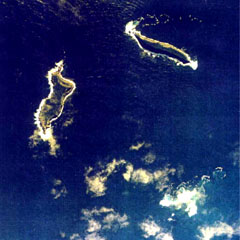Report on Hunga Tonga-Hunga Ha'apai (Tonga) — May 1988
Scientific Event Alert Network Bulletin, vol. 13, no. 5 (May 1988)
Managing Editor: Lindsay McClelland.
Hunga Tonga-Hunga Ha'apai (Tonga) Lava and tephra from shallow submarine site
Please cite this report as:
Global Volcanism Program, 1988. Report on Hunga Tonga-Hunga Ha'apai (Tonga) (McClelland, L., ed.). Scientific Event Alert Network Bulletin, 13:5. Smithsonian Institution. https://doi.org/10.5479/si.GVP.SEAN198805-243040
Hunga Tonga-Hunga Ha'apai
Tonga
20.5532°S, 175.3841°W; summit elev. 114 m
All times are local (unless otherwise noted)
Fishermen reported the beginning of an eruption E of Hunga Ha'apai Island on 1 June at 0800. They noted the ejection of "fire," tephra, and large volumes of dense white smoke/steam. Sea water nearby was warm. The next day, a Friendly Islands Airways pilot reported an active eruption at the S edge of a shoal. Vigorous steam emission was occasionally punctuated by ejection of solid material. On 3 June at 0915, a Friendly Islands flight with geologists Saimone Helu (Ministry of Lands, Tonga), Julian Pearce, and Michelle Ernewein (Newcastle Univ) was diverted to view the eruption. The eruption was continuing in shallow water ~1 km SSE of Hunga Ha'apai. Lava had apparently been erupted from three sources in a SW-NE trend extending 100-200 m, with current activity at the SW end. There was no evidence of a new island.
Geological Summary. The small andesitic islands of Hunga Tonga and Hunga Ha'apai are part of the western and northern remnants of the rim (~6 km diameter) of a largely submarine caldera located about 30 km SSE of Falcon Island. The topmost sequence of welded and unwelded ignimbrite units from a caldera-forming eruption was 14C dated to 1040-1180 CE (Cronin et al., 2017; Brenna et al. 2022). At least two additional welded pumice-rich ignimbrite units and nonwelded pyroclastic flow deposits, below paleosols and other volcaniclastic deposits, indicated more very large previous eruptions (Cronin et al., 2017; Brenna et al. 2022). Several submarine eruptions have occurred at this caldera system since the first recorded eruption in 1912, including 1937 and S of the islands in 1988. A short eruption in 2009 added land to to Hunga Ha'apai. At that time the two islands were each about 2 km long, displaying inward-facing sea cliffs with lava and tephra layers dipping gently away from the caldera. An eruption during December 2014-January 2015 was centered between the islands, and combined them into one larger structure. Major explosive eruptions in late 2021 initially reshaped the central part of the combined island before stronger activity in mid-January 2022 removed most of the 2014-15 material; an even larger eruption the next day sent an eruption plume high into the stratosphere, triggered shock waves through the atmosphere and tsunami across the Pacific Ocean, and left only small remnants of the islands above the ocean surface.
Information Contacts: R. Gatliff, S. Helu, and S. Tongilava, Ministry of Lands, Survey, and Natural Resources, Tonga; R. Singh, Mineral Resources Dept, Suva, Fiji.

